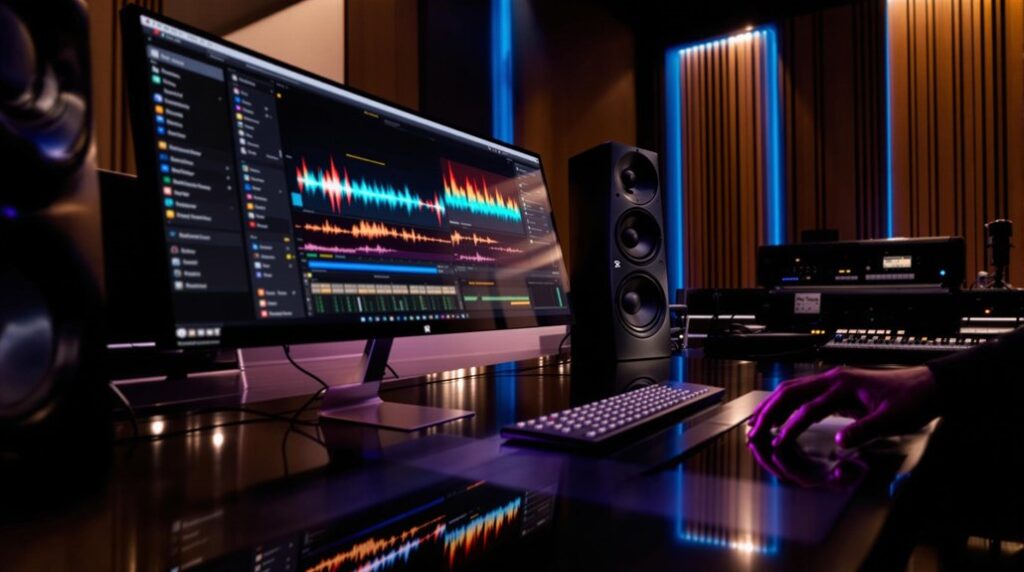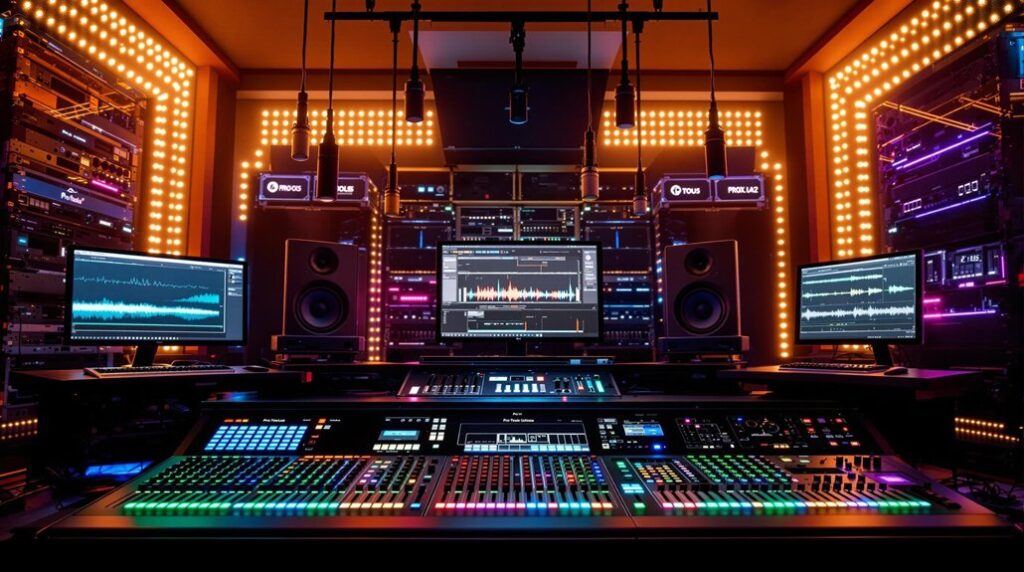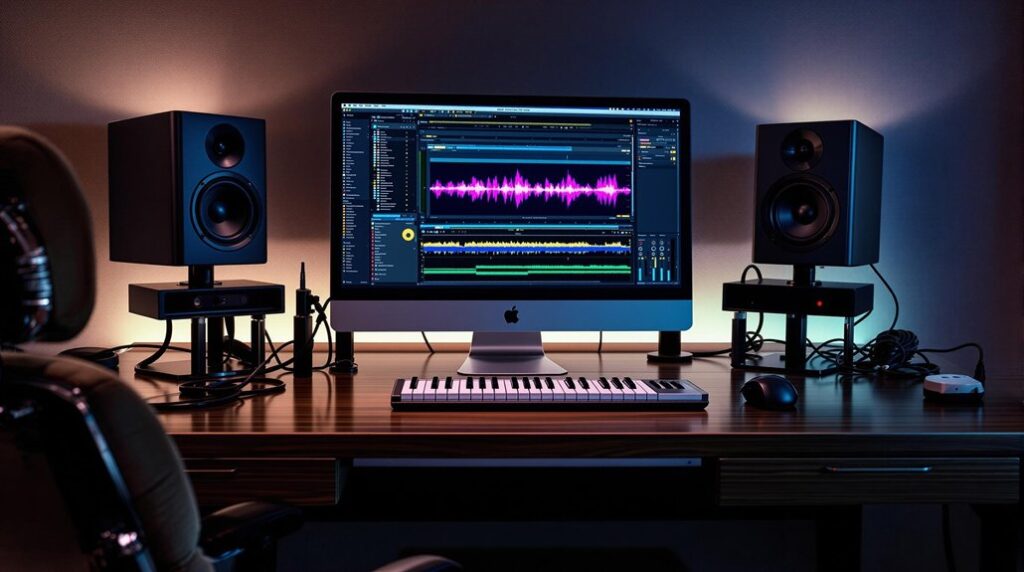Pro Tools and FL Studio cater to different audio production needs, each excelling in unique areas. Pro Tools offers advanced audio editing features like Elastic Audio and Clip Gain, and is superior for high-definition audio projects with extensive track capabilities, making it ideal for professional recording environments. In contrast, FL Studio shines in MIDI composition with its sophisticated piano roll, pattern-based sequencing, and real-time manipulation capabilities. Pro Tools relies on AAX plugins, while FL Studio supports VST and AU, offering broader plugin options. Pro Tools' subscription model contrasts with FL Studio's one-time purchase. Understanding these distinctions reveals further insights.
Key Takeaways
- Pro Tools excels in complex audio editing with Elastic Audio and advanced tools, while FL Studio focuses on MIDI composition and pattern-based sequencing.
- FL Studio offers a user-friendly interface ideal for rapid beat-making, whereas Pro Tools has a steeper learning curve with extensive functionalities.
- Pro Tools supports AAX plugins, limiting third-party options, while FL Studio's VST and AU compatibility offers a vast selection of plugins.
- Pro Tools targets professional audio engineers with a subscription model; FL Studio attracts hobbyists with a one-time purchase and lifetime updates.
- FL Studio's advanced piano roll allows real-time MIDI manipulation; Pro Tools provides basic MIDI capabilities less suited for intricate compositions.
Audio Editing Capabilities
In the field of audio editing capabilities, Pro Tools stands out with its sophisticated suite of features tailored for professional sound engineers. Renowned for advanced audio editing, Pro Tools offers tools like Elastic Audio for seamless time-stretching and pitch-shifting, enhancing flexibility in sound manipulation. Its automation tools, such as Clip Gain and Beat Detective, provide precise control over volume and timing, essential for intricate project requirements. Supporting high-definition audio with sample rates up to 192 kHz, Pro Tools guarantees superior sound quality for professional recordings. Grid Mode snaps audio clips to predetermined time increments, ensuring edits maintain precise timing and visual alignment. Conversely, FL Studio, while excelling in MIDI editing with its advanced piano roll, focuses on intuitive pattern-based sequencing. This contrast highlights Pro Tools' optimization for complex editing workflows, emphasizing its industry-leading capabilities in audio editing.
MIDI Composition Tools
When comparing MIDI composition tools, FL Studio stands out with its advanced piano roll, allowing for intricate MIDI editing and real-time manipulation, which is critical for crafting complex electronic music arrangements. Its extensive suite of built-in virtual instruments and MIDI plugins further enhances creative exploration, providing a versatile platform for electronic music producers. In contrast, Pro Tools, while equipped with MIDI capabilities, is optimized for audio recording and post-production, thereby offering a less streamlined MIDI workflow that might not satisfy the requirements of those focused on MIDI-centric composition. Pro Tools users can still benefit from customizable mappings that allow quick access to frequently used features, enhancing productivity and allowing for expressive adjustments during sessions.
Advanced MIDI Editing Features
FL Studio excels in the field of advanced MIDI editing features, offering a sophisticated piano roll that stands as a cornerstone for detailed MIDI manipulation. Its powerful tools facilitate intricate MIDI editing, supporting electronic music production with advanced automation and extensive audio recording capabilities. The intuitive step sequencer and pattern-based workflow enhance the creation of complex musical patterns, aligning seamlessly with the demands of modern composers.
| Feature | FL Studio | Pro Tools |
|---|---|---|
| Piano Roll | Advanced MIDI editing, precise control | Basic editing, limited manipulation |
| Automation | Extensive, supports dynamic changes | Limited, less flexible |
| MIDI Tools | Extensive library, creative effects | Basic features, less innovation |
FL Studio's integration of real-time MIDI input and automation options empowers users to produce dynamic, expressive performances, a distinct advantage over Pro Tools.
Real-Time MIDI Manipulation
Utilizing its robust MIDI composition tools, FL Studio distinguishes itself with unparalleled real-time MIDI manipulation capabilities, making it a preferred choice for producers focused on electronic music.
The software's advanced piano roll facilitates intricate MIDI editing, allowing for precise control over note velocity and duration. Such features enable the creation of complex patterns, enhancing the compositional flexibility of FL Studio. Its drag-and-drop functionality streamlines the integration of MIDI clips and automation, promoting an efficient workflow ideal for both novices and seasoned professionals.
Conversely, Pro Tools, while proficient in audio recording, offers basic MIDI capabilities that may feel restrictive for those requiring sophisticated manipulation.
Its less intuitive MIDI toolset limits its appeal for users prioritizing MIDI composition over audio recording, highlighting the contrast between these two DAWs.
Workflow and Interface
In comparing workflow and interface customization between Pro Tools and FL Studio, distinct approaches to user interaction and task execution emerge.
FL Studio's interface is tailored for rapid beat-making with a highly customizable design that supports intuitive sample and plugin access, optimizing workflow efficiency for electronic music producers.
Conversely, Pro Tools offers a more complex interface with its dual Edit and Mix views, granting precise control over audio and MIDI editing, albeit with a steeper learning curve that might impact initial workflow efficiency for new users. Pro Tools also supports extensive automation capabilities, allowing for dynamic audio production through its various modes like write and latch, which are essential for precise control in complex audio sessions.
Interface Customization Options
While both Pro Tools and FL Studio excel in providing versatile interface customization options, their approaches cater to different user needs and workflows.
Pro Tools offers a highly customizable layout, allowing adjustments to toolbars, window arrangements, and key commands. This flexibility enables users to tailor their workspace to streamline complex workflow demands. Users can also save and recall custom workspace configurations, adapting efficiently to varying project contexts.
In contrast, FL Studio emphasizes a visually appealing interface with movable panels and adjustable layouts. This design fosters a personalized workspace that aligns with individual production styles. Additionally, FL Studio supports split-window views, facilitating multitasking.
Although both DAWs support customizable keyboard shortcuts, Pro Tools typically requires more extensive setup, due to its intricate functionality.
Workflow Efficiency Comparison
Building upon their customizable interfaces, the workflow efficiency of Pro Tools and FL Studio reveals distinct advantages tailored to different production needs.
Pro Tools, renowned for its split interface featuring dedicated Edit and Mix windows, offers precision in managing audio tracks and editing tools, making it ideal for complex, detail-oriented projects. Its customizable key commands further enhance workflow efficiency.
Conversely, FL Studio excels in a pattern-based workflow with an advanced piano roll, facilitating quick MIDI composition and automation. This user-friendly approach, accentuated by drag-and-drop functionality, is particularly advantageous for electronic music producers.
While both DAWs demand a learning investment, FL Studio's intuitive design enables faster project initiation, contrasting with Pro Tools' more intricate, yet thorough, audio-centric focus.
Plugin Compatibility
Maneuvering through the terrain of plugin compatibility reveals significant differences between Pro Tools and FL Studio, both of which cater to distinct user needs and production environments.
Pro Tools primarily supports AAX plugins, which are optimized for seamless integration and performance within its architecture. This reliance, however, limits the breadth of third-party plugins available, as it does not natively support VST plugins. Users often resort to wrappers or converters to bridge this gap, complicating the workflow.
Conversely, FL Studio's compatibility with VST and AU plugins provides a vast selection of third-party instruments and effects, enhancing creative possibilities. Its drag-and-drop functionality further streamlines the workflow, particularly appealing to electronic music producers seeking efficiency and flexibility in their production process.
For beginners to understand plugin usage, Pro Tools offers 36 stock AAX plugins, including EQs, delays, and reverb, which are essential tools for audio enhancement and sound manipulation.
Pricing Structures
Examining the pricing structures of Pro Tools and FL Studio uncovers distinct models that significantly influence user decisions based on budget and long-term value considerations.
Pro Tools employs a subscription model, with monthly fees starting at $34.99 or an annual payment of $299. Students can benefit from a reduced rate of $9.99/month. A perpetual license is available for $599, while the Pro Tools Ultimate version costs $89.99/month or $799 annually, catering to advanced users.
Conversely, FL Studio adopts a one-time purchase approach, ranging from $99 for the Fruity Edition to $499 for the All Plugins Edition, all with lifetime updates. This model often positions FL Studio as offering superior long-term value, especially when compared to Pro Tools' recurrent costs.
User Learning Curve
How does one navigate the user learning curve when choosing between Pro Tools and FL Studio?
Pro Tools presents a steeper learning curve, attributed to its extensive functionalities aimed at professional audio production. This complexity necessitates a significant investment in learning resources, making it less user-friendly for beginners. Its advanced features, however, empower professionals to execute detailed audio editing with precision. To aid beginners, Pro Tools First offers a user-friendly interface with essential features and built-in tutorials, making it ideal for self-learning. Conversely, FL Studio offers an intuitive interface that appeals to novices and electronic music producers by facilitating quick music creation. Its user-friendly design allows individuals to engage in audio production with minimal prior knowledge. Consequently, while FL Studio is ideal for casual experimentation and rapid composition, Pro Tools remains the preferred choice for intricate projects demanding professional expertise.
Recording Features
When evaluating the recording features of Pro Tools and FL Studio, significant differences emerge in their live audio capabilities and multitrack recording options. Pro Tools excels with its high-definition audio support and extensive track counts, making it a robust solution for complex recording setups that demand precise hardware integration. Conversely, FL Studio's more straightforward interface caters primarily to MIDI composition, offering basic audio recording functionalities that may not meet the requirements of professional live tracking and intricate multitrack environments. Additionally, Pro Tools' collaboration tools enable real-time project management, allowing multiple users to work on the same session from different locations, making it a preferred choice for team-based projects.
Live Audio Capabilities
In the sphere of digital audio workstations, Pro Tools stands as the benchmark for live audio recording capabilities, underscoring its reputation as the industry standard in professional studios.
Its advanced audio capabilities support an extensive track count, facilitating the simultaneous recording of multiple audio sources. This is essential for complex sessions involving diverse instruments and vocals. Tools like Elastic Audio and Clip Gain provide precise editing, ensuring seamless integration of recordings into larger projects.
In contrast, FL Studio primarily caters to MIDI composition and electronic music, offering more basic audio recording features. With its focus on single-track recording and elementary editing options, FL Studio is less equipped for capturing high-quality live performances, highlighting Pro Tools' supremacy in professional-grade audio capture.
Multitrack Recording Options
Pro Tools' prowess in live audio recording naturally extends to its sophisticated multitrack recording capabilities, affirming its position as a leader in the digital audio workstation field.
Its advanced recording capabilities allow users to manage hundreds of audio tracks with precision, supporting unlimited track counts with seamless routing, automation, and real-time effects processing. This robust setup makes Pro Tools ideal for complex audio projects and live sessions.
Features like Track Freeze and Commit optimize CPU usage, ensuring efficiency in extensive multitrack recording scenarios.
In contrast, FL Studio, though competent in multitrack recording, focuses primarily on MIDI composition, handling audio tracks in a more streamlined manner.
Pro Tools' integration with professional audio interfaces further enhances its capability, providing superior audio capture and control.
Hardware Integration Benefits
Seamless hardware integration stands as a pivotal advantage in utilizing the full potential of Pro Tools for professional audio production. The synergy between Pro Tools and Avid's hardware interfaces guarantees superior audio fidelity, a necessity within professional studios.
This integration facilitates several key recording features:
- Hybrid Engine: Optimizes CPU usage, allowing for enhanced track count and efficient management of complex audio projects.
- Real-time Input Monitoring: Offers immediate feedback during recording sessions, streamlining workflow and enhancing creative processes.
- Advanced Routing Options: Provides flexible signal paths, enabling customized setups tailored to diverse recording scenarios.
- External Hardware Integration: Incorporates microphones and preamps, augmenting audio fidelity and enriching the all-encompassing suite of recording features essential for high-quality production.
These elements collectively empower Pro Tools to deliver unmatched recording capabilities.
Mixing and Mastering
Mixing and mastering in digital audio workstations (DAWs) require precision and flexibility, both of which are offered by Pro Tools and FL Studio in distinct ways.
Pro Tools stands out with its advanced mixing capabilities, providing a virtual mixing console equipped with high-definition audio support and precise automation tools. Its editing features, such as Clip Gain and Elastic Audio, enhance the precision of mixing and mastering, allowing detailed manipulation of audio tracks. Mastery of signal routing in Pro Tools ensures effective audio processing and prevents technical issues like clipping and overloads, which is crucial for maintaining dynamic range.
FL Studio, characterized by its user-friendly interface, excels with a flexible mixer that supports multiple routing options. It offers built-in mastering tools like Fruity Limiter and Maximus, with real-time effects processing and dynamic automation, catering particularly to electronic music.
Both DAWs guarantee robust third-party plugin support.
Community and Support
While both Pro Tools and FL Studio offer distinct strengths in mixing and mastering, their support and community ecosystems are equally pivotal for users traversing the complexities of audio production.
Pro Tools commands a robust community of audio professionals, providing an extensive array of training resources, certification programs, and forums. Users benefit from Avid's support portal, rich with technical documentation tailored for professional environments. Pro Tools is known for its comprehensive suite of plugins like iZotope Ozone, which includes EQ, compression, and limiting tools that are vital for mastering.
Conversely, FL Studio thrives with an active online community of hobbyists and electronic music producers. Its community-driven approach fosters peer support through:
- Extensive tutorials and user-generated content.
- A plethora of user-created plugins and samples.
- Detailed FAQs enhancing user resources.
- Interactive forums for collaborative problem-solving.
Both DAWs equip users with essential support networks, yet cater to distinct user bases.
Suitability for Projects
Evaluating the suitability of Pro Tools and FL Studio for various projects requires an understanding of their core capabilities and intended use cases.
Pro Tools, as a professional audio digital audio workstation, excels in projects involving complex audio recording, editing, and mixing. Its robust recording features and extensive track support make it ideal for film scoring and music album production, where precise audio manipulation is essential.
Conversely, FL Studio is tailored for electronic music production, focusing on MIDI composition and beat-making, making it highly suitable for projects reliant on loops, samples, and virtual instruments. Its intuitive interface suits different user levels, from beginners to hobbyists seeking quick music creation.
Pro Tools offers advanced MIDI merge functionality which allows layering of MIDI data without overwriting existing tracks, making it a strong choice for intricate MIDI projects.
Consequently, both workstations serve distinct project requirements within the audio production spectrum.
Frequently Asked Questions
What Is the Difference Between Pro Tools and FL Studio?
Pro Tools and FL Studio differ greatly in music production applications. Pro Tools excels in audio editing and live recording with a detailed software interface, while FL Studio offers efficient workflow and robust plugin compatibility, favoring electronic music composition.
Do Any Professional Musicians Use FL Studio?
Professional musicians, particularly in electronic and hip-hop genres, extensively utilize FL Studio due to its robust features, diverse plugins, and streamlined workflow. Prominent FL Studio users, such as Deadmau5, leverage its capabilities to craft innovative compositions.
What Is the Disadvantage of FL Studio?
FL Studio's limitations include workflow challenges due to its complex user interface, potential plugin compatibility issues, and resource-intensive sound libraries, which may hinder performance. These factors can impact efficient project management and overall user experience.
Why Do Most Studios Use Pro Tools?
Most studios utilize Pro Tools due to its superior recording quality, advanced editing capabilities, and adherence to industry standards. Its workflow efficiency and compatibility with professional hardware minimize compatibility issues, making it indispensable for high-demand studio environments.
Conclusion
In comparing Pro Tools and FL Studio, distinct differences emerge across multiple dimensions, including audio editing capabilities, MIDI composition tools, workflow, interface, and plugin compatibility. The pricing structures and recording features further delineate their target audiences, with mixing and mastering capabilities tailored to specific professional needs. Community support also varies, influencing user experience. Ultimately, suitability for projects hinges on the unique requirements of the user, with each software offering strengths that cater to different aspects of music production.




